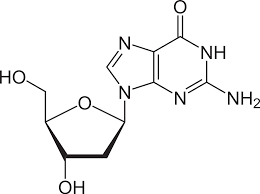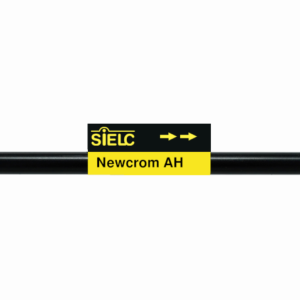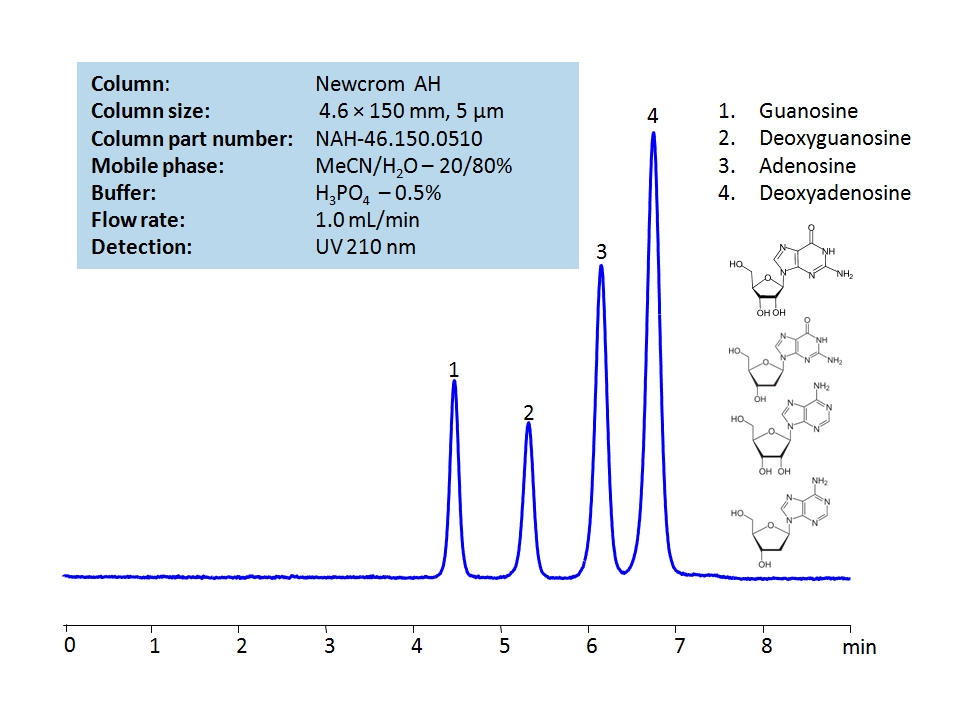| CAS Number | 961-07-9 |
|---|---|
| Molecular Formula | C10H13N5O4 |
| Molecular Weight | 267.24 |
| InChI Key | YKBGVTZYEHREMT-KVQBGUIXSA-N |
| LogP | -0.9 |
| Synonyms |
|
Applications:
Ionic Modifier Effect on Selectivity of Separation of Deoxyguanosine, Guanine and Guanosine on BIST B+
December 5, 2022
Ionic Modifier Effect on Selectivity of Separation of Deoxyguanosine, Guanine, Guanosine on BIST B+ by SIELC Technologies.
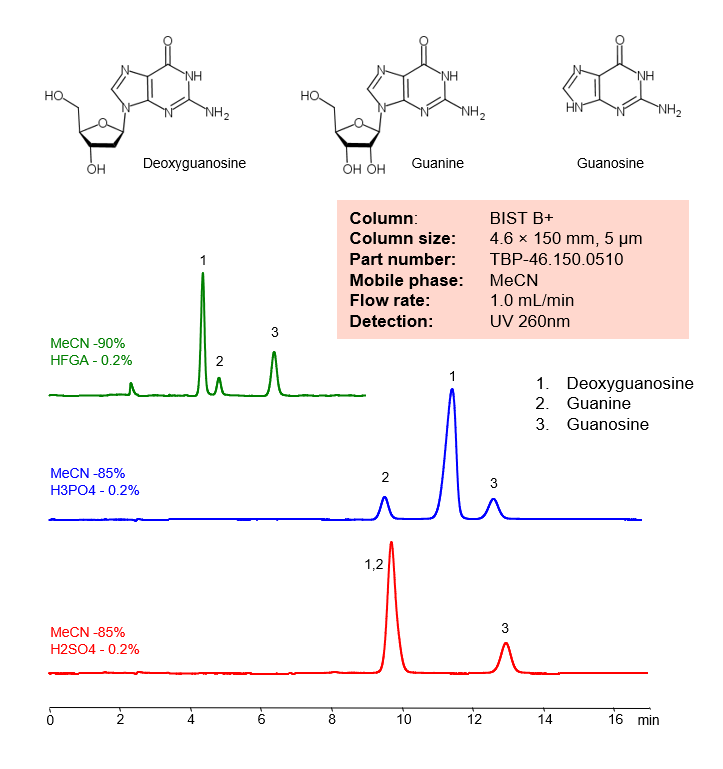
Deoxyguanosine is a deoxyribonucleoside with the chemical formula C10H13N5O4. It is a vital part of what makes up DNA.
Guanine, also noted as G and Gua, has the chemical formula C5H5N5O. By forming three hydrogen bonds with the Cytosine, it creates a base pair. It’s name comes from the Spanish term “guano”, meaning bird or bat dropping, as that is said to have been how it was first discovered. Outside of DNA, Guanine that is harvested from fish scales, is occasionally used in cosmetics for it’s luster.
Guanosine is a purine nucleoside with the chemical formula C10H13N5O5. It can be phosphorylated into many other forms, which play vital roles in biochemical possesses like synthesis of nucleic acids, proteins, photosynthesis, and more. It is also required for RNA splicing.
Deoxyguanosine, Guanine, Guanosine can be retained and analyzed using the BIST B+ stationary phase column. The analysis utilizes an isocratic method with a simple mobile phase consisting of water and acetonitrile (MeCN). Detection is performed using UV.
Condition
| Column | BIST B+, 4.6 x 150 mm, 5 µm, 100 A, dual ended |
| Mobile Phase | MeCN |
| Buffer | H3PO4, H2SO4, HFGA (Hexafluoroglutaric acid) – 0.2%, |
| Flow Rate | 1.0 ml/min |
| Detection | UV 260 nm |
Description
| Class of Compounds | Nucleosides |
| Analyzing Compounds | Deoxyguanosine, Guanine, Guanosine |
Application Column
BIST B+
Column Diameter: 4.6 mm
Column Length: 150 mm
Particle Size: 5 µm
Pore Size: 100 A
Column options: dual ended
Guanine
Guanosine

HPLC Method for Analysis of Deoxyguanosine, Guanine and Guanosine on BIST B+
December 5, 2022
HPLC Method for Analysis of Deoxyguanosine, Guanine and Guanosine on BIST B+ by SIELC Technologies.
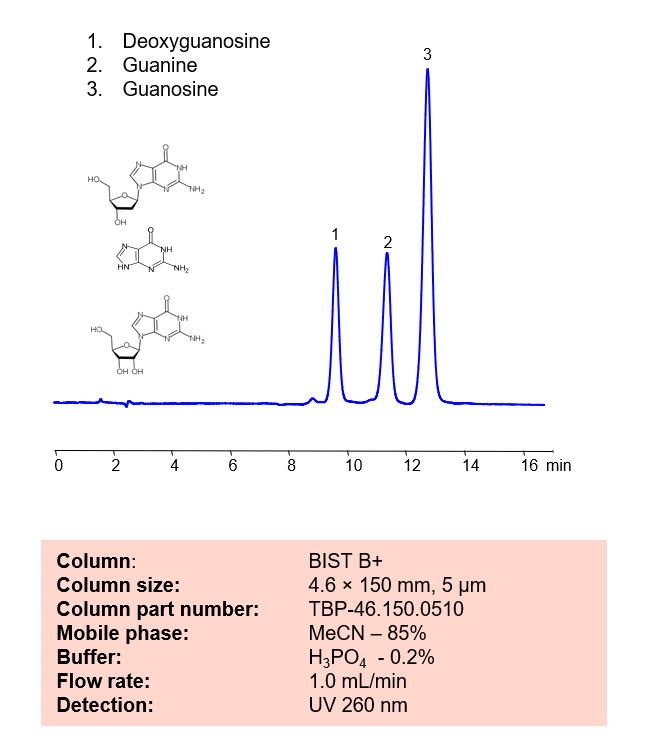
Deoxyguanosine is a deoxyribonucleoside with the chemical formula C10H13N5O4. It is a vital part of what makes up DNA.
Guanine, also noted as G and Gua, has the chemical formula C5H5N5O. By forming three hydrogen bonds with the Cytosine, it creates a base pair. It’s name comes from the Spanish term “guano”, meaning bird or bat dropping, as that is said to have been how it was first discovered. Outside of DNA, Guanine that is harvested from fish scales, is occasionally used in cosmetics for it’s luster.
Guanosine is a purine nucleoside with the chemical formula C10H13N5O5. It can be phosphorylated into many other forms, which play vital roles in biochemical possesses like synthesis of nucleic acids, proteins, photosynthesis, and more. It is also required for RNA splicing.
Guanine, Guanosine, Deoxyguanosine can be retained and analyzed using the BIST B+ stationary phase column. The analysis utilizes an isocratic method with a simple mobile phase consisting of water and acetonitrile (MeCN). Detection is performed using UV.
Condition
| Column | BIST B+, 4.6 x 150 mm, 5 µm, 100 A, dual ended |
| Mobile Phase | MeCN – 85% |
| Buffer | H3PO4 – 0.2% |
| Flow Rate | 1.0 ml/min |
| Detection | UV 260 nm |
| Peak Retention Time | 9.6, 11.2, 12.8 min |
Description
| Class of Compounds | Nucleosides |
| Analyzing Compounds | Guanine, Guanosine, Deoxyguanosine |
Application Column
BIST B+
Column Diameter: 4.6 mm
Column Length: 150 mm
Particle Size: 5 µm
Pore Size: 100 A
Column options: dual ended
Guanine
Guanosine

HPLC Separation of 2′-Deoxy-2′-fluoroguanosine and Deoxyguanosine on Newcrom AH Cloumn
June 1, 2021
HPLC Method for Deoxyguanosine, 2'-Deoxy-2'-fluoroguanosine on Newcrom AH by SIELC Technologies
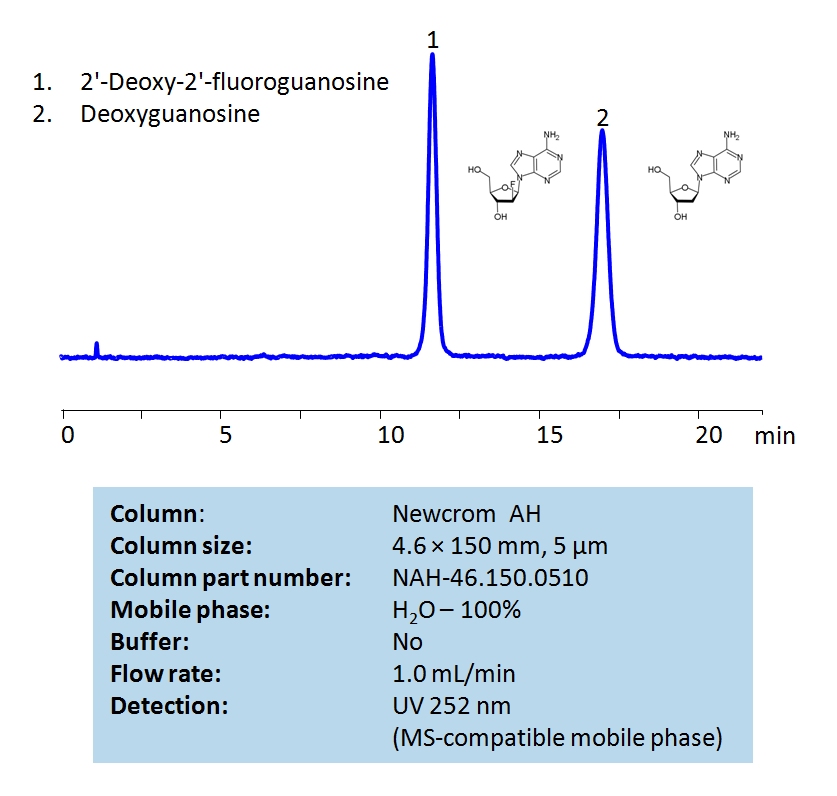
High Performance Liquid Chromatography (HPLC) Method for Analysis of 2′-Deoxy-2′-fluoroguanosine and Deoxyguanosine
Nucleosides are the building blocks for DNA and RNA as well as other roles in biomechanical processes such as signal transduction. 2′-Deoxy-2′-fluoroguanosine is an antiviral nuceloside that can help the body fight influenza A & B. Deoxyguanosine is one of the four core deoxyribonucleosides that compose DNA. The only difference chemically is the addition of a fluorine atom on the non-Nitrogen ring.
2′-Deoxy-2′-fluoroguanosine and Deoxyguanosine can be detected in the high UV regime. Using a Newcrom AH mixed-mode column and a mobile phase consisting of just water (without a buffer), 2′-Deoxy-2′-fluoroguanosine and Deoxyguanosine can be retained, separated, and analyzed. This analysis method can be UV detected at 252 nm with high resolution. This method is compatible with Mass Spectrometry.
| Column | Newcrom AH, 4.6 x 150 mm, 5 µm, 100 A, dual ended |
| Mobile Phase | H2O – 100% |
| Buffer | No |
| Flow Rate | 1.0 ml/min |
| Detection | UV, 252 nm |
| Class of Compounds |
Nucleatide |
| Analyzing Compounds | Deoxyguanosine, 2'-Deoxy-2'-fluoroguanosine |
Application Column
Newcrom AH
Column Diameter: 4.6 mm
Column Length: 150 mm
Particle Size: 5 µm
Pore Size: 100 A
Column options: dual ended
Deoxyguanosine

HPLC Separation of Guanosine, Deoxyguanosine, Adenosine, Deoxyadenosine on Newcrom AH Column
May 25, 2021
HPLC Method for Adenosine, Guanosine, Deoxyguanosine, Deoxyadenosine on Newcrom AH by SIELC Technologies
High Performance Liquid Chromatography (HPLC) Method for Analysis of Adenosine, Guanosine, Deoxyguanosine, Deoxyadenosine.
Guanosine is a purine nucleoside with the chemical formula C10H13N5O5. It can be phosphorylated into many other forms, which play vital roles in biochemical possesses like synthesis of nucleic acids, proteins, photosynthesis, and more. It is also required for RNA splicing.
Deoxyguanosine is a deoxyribonucleoside with the chemical formula C10H13N5O4. It is a vital part of what makes up DNA.
Adenosine is a key building block of energy-carrying molecules with the chemical formula C10H13N5O4. It has a variety of other uses, including being a inhibitory neurotransmitter which helps with sleep and acting as a blood flow regulator. Medicinally, it is used as treatment for supraventricular tachycardia (SVT). You can find detailed UV spectra of Adenosine and information about its various lambda maxima by visiting the following link.
Deoxyadenosine is a deoxyribonucleoside with the chemical formula C10H13N5O3. It is a derivative of adenosine. High presence of it can kill T lymphocytes and kill those cells, leading to adenosine deaminase severe combined immunodeficiency disease, also known as ADA-SCID.
Adenosine, Guanosine, Deoxyguanosine, Deoxyadenosine are the building blocks for DNA and RNA as well as other roles in biomechanical processes such as signal transduction. By using a Newcrom AH mixed-mode column with a cation-exchange mechanism, nucleosides: guanosine, deoxyguanosine, adenosine, and deoxyadenosine, can be baseline separated in a short time using an isocratic method with a simple mobile phase of water, acetonitrile (MeCN, ACN), and H3PO4 as a buffer. UV detection at 210 nm.
| Column | Newcrom AH, 4.6 x 150 mm, 5 µm, 100 A, dual ended |
| Mobile Phase | MeCN/H2O – 20/80% |
| Buffer | H3PO4 – 0.5% |
| Flow Rate | 1.0 ml/min |
| Detection | UV, 210 nm |
| Class of Compounds |
Nucleoside, Hydrophilic, Ionizable |
| Analyzing Compounds | Adenosine, Guanosine, Deoxyguanosine, Deoxyadenosine |
Application Column
Newcrom AH
Column Diameter: 4.6 mm
Column Length: 150 mm
Particle Size: 5 µm
Pore Size: 100 A
Column options: dual ended
Deoxyadenosine
Deoxyguanosine
Guanosine

HPLC Separation of Nucleosides and Deoxynucleosides
July 23, 2012
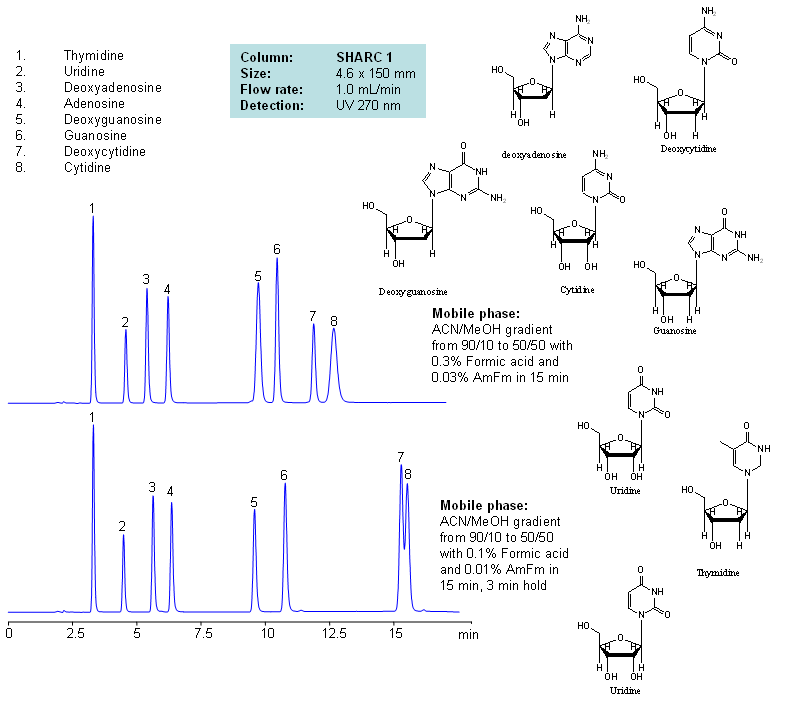
| Column | Sharc 1, 4.6×150 mm, 5 µm, 100A |
| Mobile Phase | MeCN/MeOH |
| Buffer | AmFm, Formic acid |
| Flow Rate | 1.0 ml/min |
| Detection | UV, 270 nm |
| Class of Compounds |
Drug, Acid, Hydrophilic, Ionizable, Vitamin, Supplements |
| Analyzing Compounds | Thymidine, Uridine, Deoxyadenosine, Adenosine, Deoxyguanosine, Guanosine, Deoxycytidine, Cytidine |
Application Column
SHARC 1
The SHARC™ family of innovative columns represents the first commercially available columns primarily utilizing separation based on hydrogen bonding. SHARC stands for Specific Hydrogen-bond Adsorption Resolution Column. Hydrogen bonding involves an interaction or attraction between a bound hydrogen atom and molecules containing electronegative atoms, such as oxygen, nitrogen, and fluorine.
Select optionsCytidine
Deoxyadenosine
Deoxycytidine
Deoxyguanosine
Guanosine
Thymidine
Uridine

Separation of Deoxyribo Nucleosides
September 24, 2003
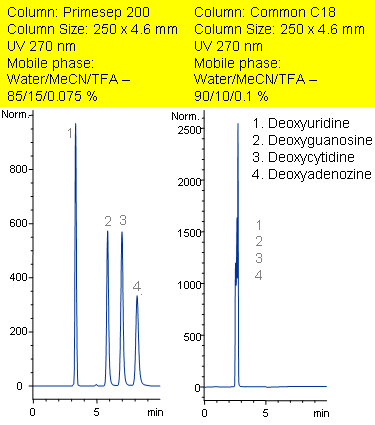
Primesep 200 separates with baseline resolution the nucleosides (deoxyuridine, deoxyguanosine, deoxycytidine, deoxyadenozine) by a combination of cation exchange and reversed phase. These compounds are not retained on a traditional C18 column. Primesep 200 has an embedded anionic functional group which helps retain polar compounds by polar and ion-exchange mechanisms. Excellent peak shape results with a mass spec compatible mobile phase of water, acetonitrile (MeCN, ACN) and trifluoracetic acid (TFA) with UV detection at 270 nm.
Application Column
Primesep 200
Column Diameter: 4.6 mm
Column Length: 250 mm
Particle Size: 5 µm
Pore Size: 100 A
Column options: dual ended
Deoxycytidine
Deoxyguanosine
Deoxyuridine

